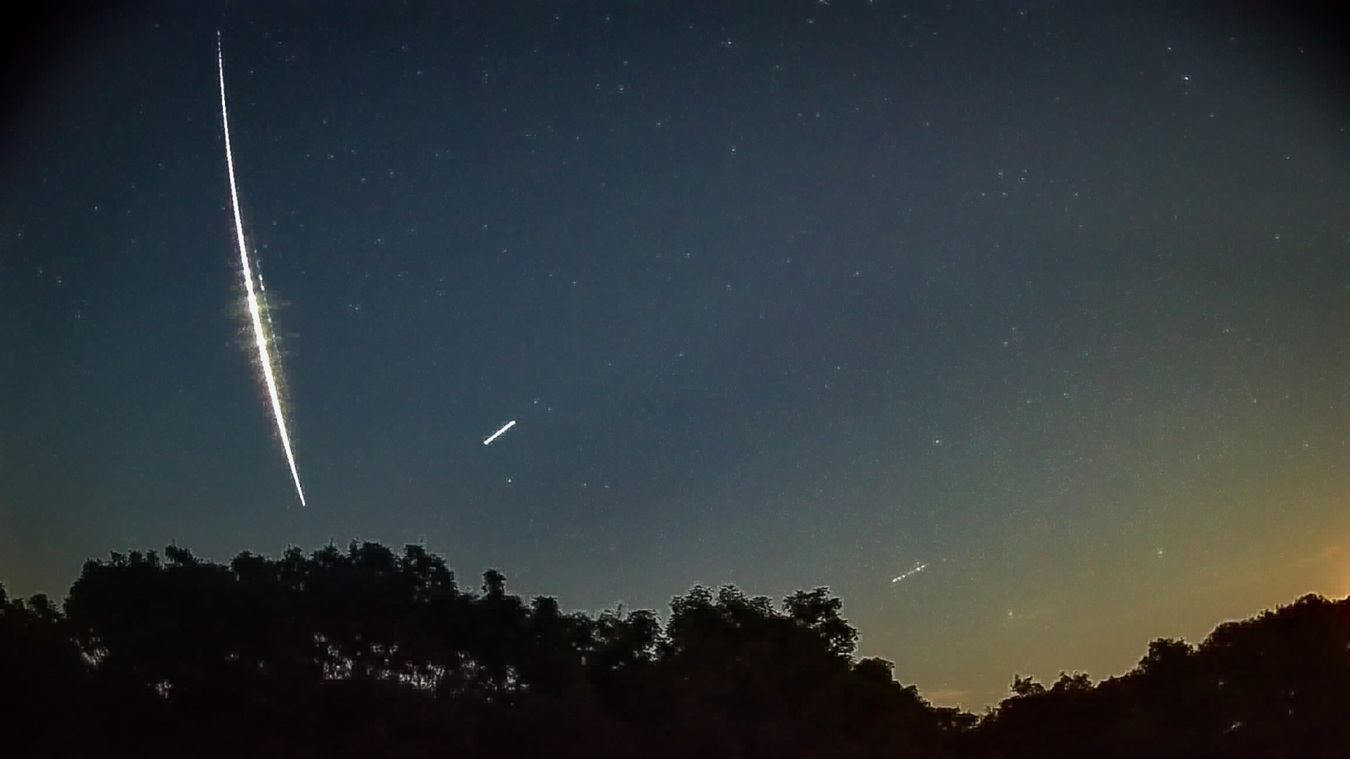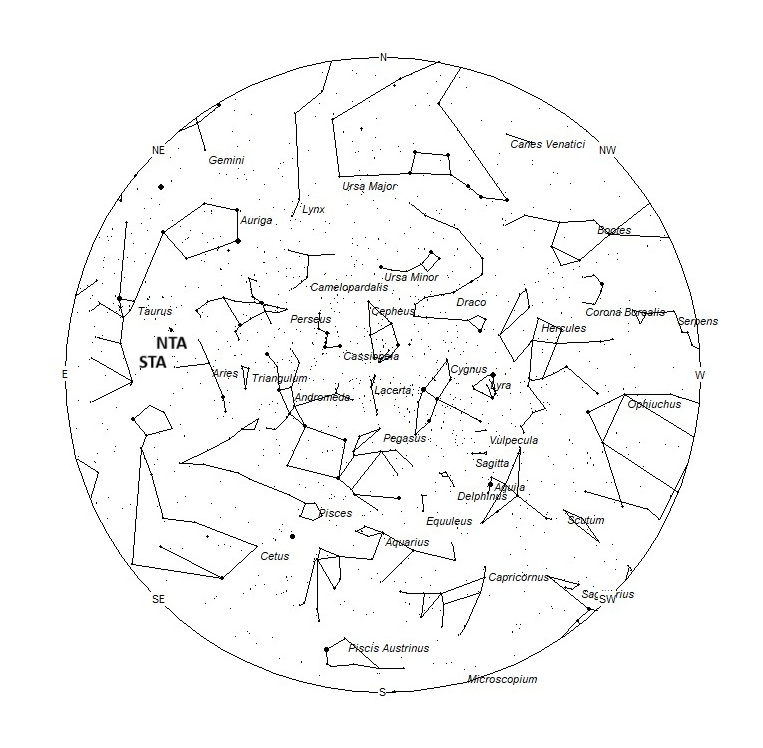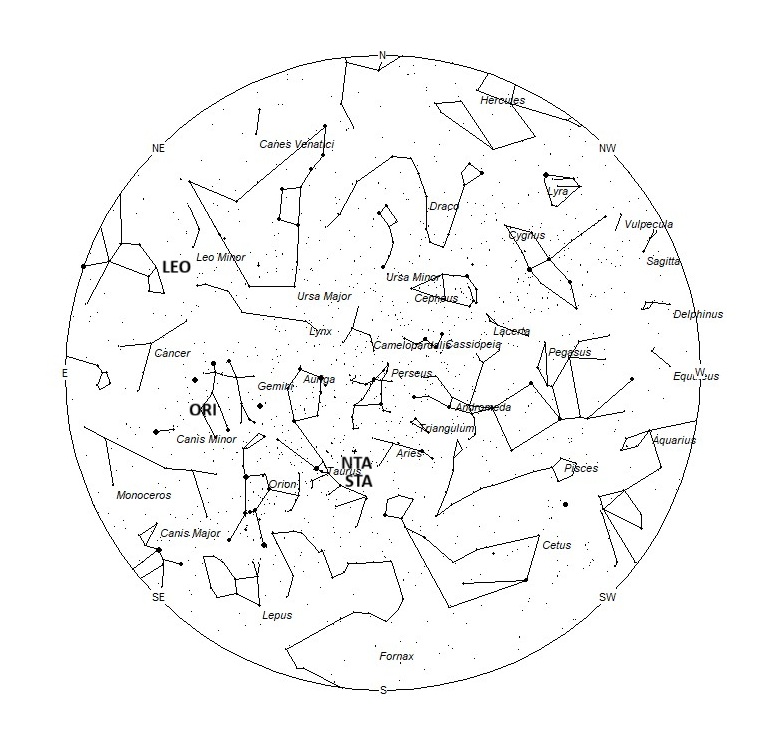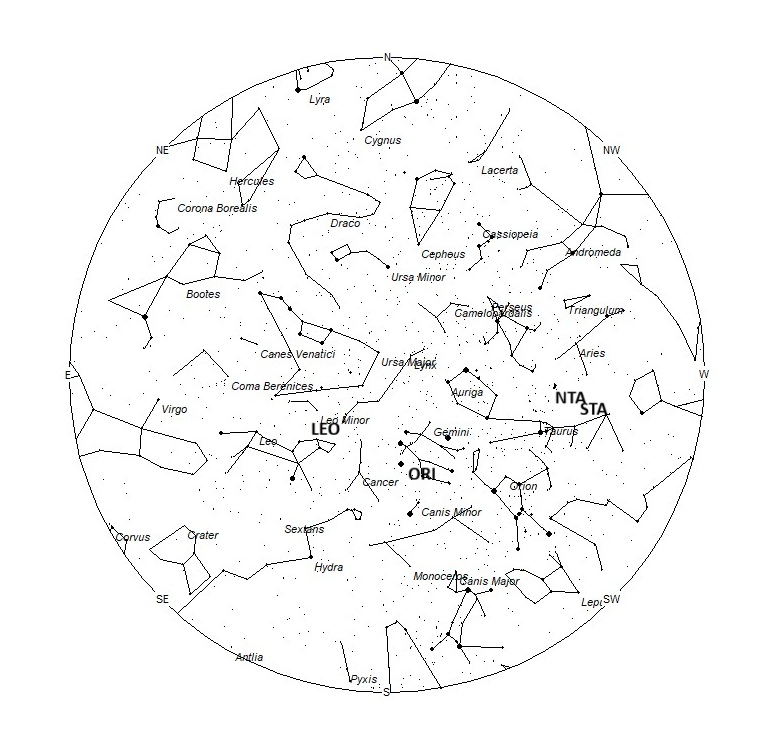 Mark Kirschner captured this brilliant fireball using his AllSky Camera System on August 8, 2025, at 20:59 EDT (00:20 UT on August 9) from North Branford, Connecticut, USA. The dashed secondary streak to the right of the fireball is a camera artifact due to the extreme brightness of this object. ©Mark Kirschner
Mark Kirschner captured this brilliant fireball using his AllSky Camera System on August 8, 2025, at 20:59 EDT (00:20 UT on August 9) from North Branford, Connecticut, USA. The dashed secondary streak to the right of the fireball is a camera artifact due to the extreme brightness of this object. ©Mark KirschnerDuring this period, the Moon reaches its last quarter phase on Wednesday, November 12th. On that date, the moon will be located 90 degrees west of the sun and will rise near 2200 local standard time (LST) on the previous evening. This weekend the waning gibbous moon will rise during the mid-evening hours, allowing a small window of opportunity to view meteor activity under dark skies between dusk and moon rise.
The estimated total hourly rates for evening observers this weekend should be near 3 as seen from mid-northern latitudes (45°N) and 2 as seen from tropical southern locations (25°S). For morning observers, the estimated total hourly rates should be near 14 as seen from mid-northern latitudes (45°N) and 8 as seen from tropical southern locations (25°S). late evening and morning rates are reduced due to lunar interference.
The actual rates observed will also depend on factors such as personal light and motion perception, local weather conditions, alertness, and experience in watching meteor activity. Note that the hourly rates listed below are estimates based on observations from dark-sky sites away from urban light sources. Observers viewing from urban areas will see less activity, as only the brighter meteors will be visible from such locations.
The radiant (the area of the sky from which meteors appear to originate) positions and rates listed below are exact for Saturday night/Sunday morning, November 8/9. These positions do not change greatly from day to day, so the listed coordinates may be used throughout this entire period. Most star atlases (available online, in bookstores, and at planetariums) include maps with celestial coordinate grids that can help you locate these positions in the sky.
I have also included charts of the sky that display the radiant positions for evening, midnight, and morning. The center of each chart represents the sky directly overhead at the corresponding hour. These charts are oriented for facing south but can be used for any direction by rotating them accordingly. A planisphere or planetarium app is also useful for showing the sky at any time of night on any date of the year.
Activity from each radiant is best seen when it is positioned highest in the sky (culmination), either due north or south along the meridian, depending on your latitude. Radiants that rise after midnight will not reach their highest point in the sky until daylight; therefore, it is best to view them during the last few hours of the night.
It must be remembered that meteor activity is rarely seen directly at the radiant position. Rather, meteors shoot outward from the radiant, so it is best to center your field of view so that the radiant lies near the edge rather than the center. Viewing in this way allows you to trace the path of each meteor back to the radiant (if it belongs to a shower) or in another direction if it is sporadic. Meteor activity is not visible from radiants located far below the horizon.
The positions below are listed in west-to-east order by right ascension (celestial longitude). The positions listed first are located farther west and are therefore accessible earlier in the night, while those listed farther down the list rise later.
These sources of meteoric activity are expected to be active this week
.
The Northern Taurids (NTA) should be active from a wide radiant located at 03:44 (056) +22. This area of the sky lies in western Taurus, 3 degrees southwest of the naked eye star cluster known as the Pleiades. To best see these meteors, observers should face southward near 01:00 LST. To differentiate between the Northern and Southern Taurids, face toward these radiants, as they lie close together in the sky. Rates at this time should be near 2 per hour, as seen from the northern hemisphere and 1 as seen from south of the equator. With an entry velocity of 28 km/sec, the average NTA meteor would be of medium-slow velocity.
The wide radiant for the Southern Taurids (STA) is centered near 03:44 (056) +15. This area of the sky lies in western Taurus, 3 degrees northeast of the 4th-magnitude star 5 Tauri. This radiant is best placed near 01:00 LST, when it lies on the meridian and is highest in the southern sky. Rates at this time should be near 2 per hour, regardless of location. With an entry velocity of 27 km/sec, the average STA meteor would also be of medium-slow velocity. Many fireballs from this source have already been reported lately, so monitoring this shower may be rewarding even though the moon is interfering at this time.
The Orionids (ORI) are active from October 2 through November 12, with maximum activity occurring on October 23rd. The radiant is currently located at 07:20 (180) +17, which places it in southern Gemini, near the 4th magnitude star known as lambda Geminiorum. This area of the sky is best placed for observing during the last dark hour before dawn, when it lies highest in the southern sky. Current rates as seen from the northern hemisphere are expected to be near 1 per hour. Rates from the southern hemisphere are expected to be less than 1 per hour. With an entry velocity of 65 km/sec, the average ORI meteor would be of swift velocity
The Leonids (LEO) are active from October 27 to December 7 with maximum activity occurring on November 17th. The radiant is currently located at 09:48 (147) +28. This position lies in northwestern Leo, 2 degrees north of the 4th magnitude star known as mu Leonis. The Leonid radiant is best placed in the eastern sky during the last hour before morning twilight when the radiant lies highest in a dark sky. Leonids may be seen from the southern hemisphere, but the viewing conditions are not quite as favorable as those north of the equator. Current rates are expected to be 2 per hour as seen from the northern hemisphere and 1 per hour as seen south of the equator. With an entry velocity of 69 km/sec., most activity from this radiant would be of swift speed with numerous persistent trains on the brighter meteors.
Sporadic meteors are those that cannot be associated with any known meteor shower. All meteor showers evolve and disperse over time until they are no longer recognizable. Away from the peaks of major annual showers, these sporadic meteors make up the bulk of the activity seen each night.
As seen from the mid-northern hemisphere (45°N), one would expect to see approximately 8 sporadic meteors per hour during the last hour before dawn, from rural observing sites. Evening rates would be near 3 per hour. From tropical southern latitudes (25°S), morning rates would be around 6 per hour and 2 per hour during the evening. Locations between these two extremes would experience activity between these figures. Late evening and morning rates are reduced due to moonlight.
The list below provides tabular information on the active showers that are within reach of the visual observer to discern. Rates and positions in the table are exact for Saturday night/Sunday morning November 1/2.
| SHOWER | DATE OF MAXIMUM ACTIVITY | CELESTIAL POSITION | ENTRY VELOCITY | CULMINATION | HOURLY RATE | CLASS |
| RA (RA in Deg.) DEC | Km/Sec | Local Standard Time | North-South | |||
| Northern Taurids (NTA) | Nov 12 | 03:44 (056) +22 | 29 | 01:00 | 2 – 1 | II |
| Southern Taurids (STA) | Nov 05 | 03:44 (056) +15 | 27 | 01:00 | 2 – 1 | II |
| Orionids (ORI) | Oct 21 | 07:20 (180) +17 | 66 | 04:00 | 1 – <1 | I |
| Leonids (LEO) | Nov 17 | 09:48 (147) +28 | 70 | 07:00 | 1 – <1 | I |
Class Explanation: A scale to group meteor showers by their intensity:
- Class I: the strongest annual showers with Zenith Hourly Rates normally ten or better.
- Class II: reliable minor showers with ZHR’s normally two to ten.
- Class III: showers that do not provide annual activity. These showers are rarely active yet have the potential to produce a major display on occasion.
- Class IV: weak minor showers with ZHR’s rarely exceeding two. The study of these showers is best left to experienced observers who use plotting and angular velocity estimates to determine shower association. These weak showers are also good targets for video and photographic work. Observers with less experience are urged to limit their shower associations to showers with a rating of I to III.







 You saw something bright and fast? Like a huge shooting star? Report it: it may be a fireball.
You saw something bright and fast? Like a huge shooting star? Report it: it may be a fireball.  You counted meteors last night? Share your results with us!
You counted meteors last night? Share your results with us!  You took a photo of a meteor or fireball? You have a screenshot of your cam? Share it with us!
You took a photo of a meteor or fireball? You have a screenshot of your cam? Share it with us!  You caught a meteor or fireball on video? Share your video with us!
You caught a meteor or fireball on video? Share your video with us!